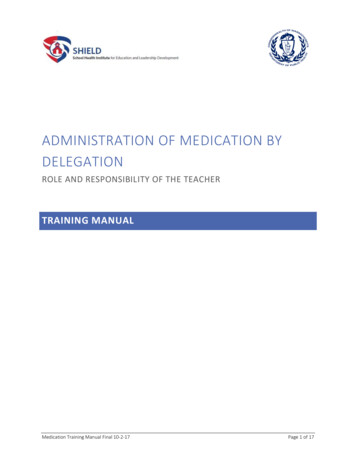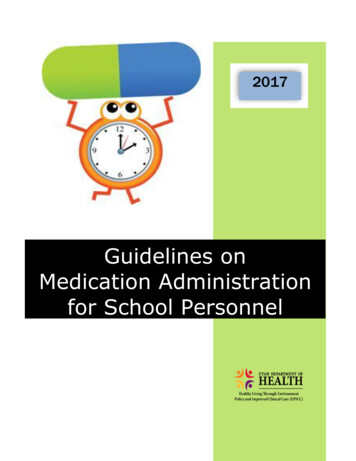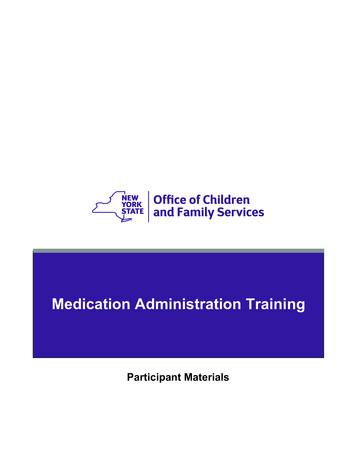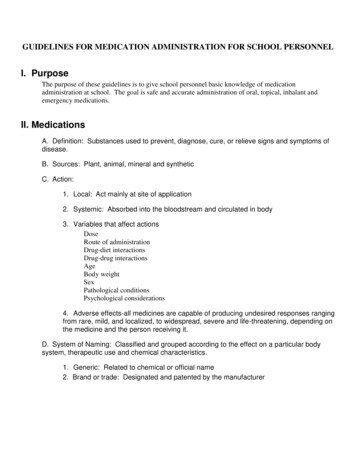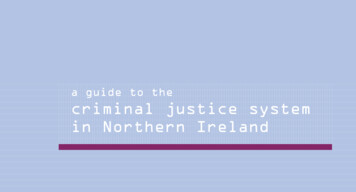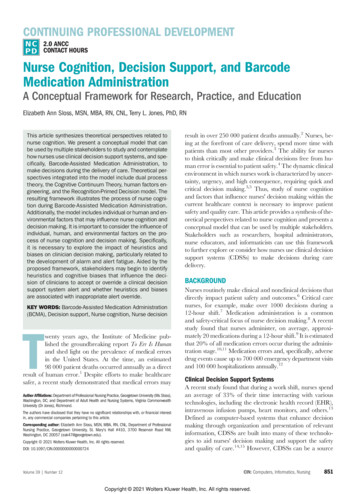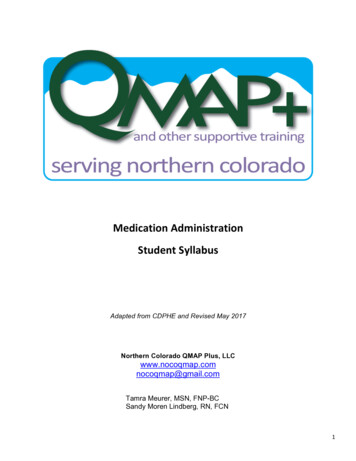
Transcription
Medication AdministrationStudent SyllabusAdapted from CDPHE and Revised May 2017Northern Colorado QMAP Plus, LLCwww.nocoqmap.comnocoqmap@gmail.comTamra Meurer, MSN, FNP-BCSandy Moren Lindberg, RN, FCN1
Table of ContentsOverview3Unit 1 – Concepts, Special Population Considerations and Re-Qualification7Unit 2 – Uses and Forms of Drugs11Unit 3 – Medication Orders15Unit 4 – Medication Administration Records (MAR)25Unit 5 – MRBs and CMDDs29Unit 6 – Medication Administration Procedures and Universal Precautions32Unit 7– Medication Errors42Unit 8 – Medication Storage44Additional Definitions452
Statutory and Regulatory authorityOVERVIEWThe medication administration program is established in accordance with Section 25-1.5-301, C.R.Set seq.Health Facilities Division (HFD) -6 CCR 1011-1 standards for hospitals and health facilities. ChapterXXIV – Medication Administration Regulations (amended 11/18/09), (effective 12/30/09)PurposeThe medication administration program is established in accordance with Section 25-1.5-301, C.R.S etseq. The medication administration course is designed to teach unlicensed staff to safely administermedications in settings authorized by law. Staff who successfully complete the medicationadministration course are not certified or licensed in any way, and are not trained or authorized tomake any type of judgment, assessment or evaluation of a client. Staff who successfully complete thecourse are considered Qualified Medication Administration Persons (QMAP). Successful applicantswill pass written exam and a hands-on practical exam.The Importance of Safe Administration of Medications The administration of medications is a privilege.This role is a major responsibility that affects the quality of clients' lives.Improper or careless administration of medications may result in death.You are responsible for what you administer. It is best practice to administermedications that you have prepared.o You may administer medications using medication reminder boxes(MRBs) that others (client, family, other facility staff) have prepared.Administering medications is a very important task. Current regulations and requirements formedication administration in Colorado became effective July 1, 2017. One of the requirements is thatany unlicensed person administering medications or supervising the administration of medicationsmust pass a test approved by the state of Colorado. Once a person successfully completes anapproved QMAP course, it is not necessary to repeat the class or testing unless required by anemployer. Information such as schedules and changes regarding medication testing may be found onour website at http://www.nocoqmap.comThe purpose of the Medication Study Guide is to help you become more knowledgeable withadministering medications and better prepared for the test.This study guide was also developed as a training tool in addition to on the job training you willreceive from your employer. Remember, this study booklet is only a guide! The questions on the testwill be similar to the questions in this study guide. There will be questions on the test pertaining toeach of the areas in the study guide.We all know that taking tests can be stressful. The medication administration test being given byQMAP will be on the basics of medication administration. Using this study guide should help younot only be better prepared for the test but also become more knowledgeable and skilled withadministering medications. Becoming more competent in administering medications will help clientsin authorized designated settings avoid serious medication-related problems.3
Course objectives Safe administration of medications according to written physician's/provider’s ordersMaintaining proper documentation of the administration of both prescription and nonprescription drugsUse of proper techniques when administering medications by the various routes to includeoral/ingestion, transdermal, topical/application, inhaled/nebulizer, and insertion ofsuppositories/creams (rectal or vaginal) and enemasDemonstrate compliance with the 7 rightsYou will know and demonstrate mastery of the following:A. Comprehension of important guidelines including the elderly, physically or cognitivelyimpaired, behavioral issues, as well as neglect or abuse of clientsB. Use and forms of drugsC. Medication ordersD. DocumentationE. Medication reminder boxesF. Steps of procedures to ensure accurate administration and documentation ofmedicationsG. Medication errors, diversion and reporting to law enforcementH. Medication storage & destruction of medsSafely and accurately fill and administer medications to and from medication reminderboxesBe able to discuss compartmentalized systems of medicationsEmergency use of Epi-Pens in accordance with 1st Aid CertificationAt the completion of this course, you should be able to demonstrate:! Proper reading, understanding and transcribing of physician’s orders! Safe administration of medications via multiple "routes" (ingested, applied, inhaled, inserted)in designated settings using written physician orders according to the "7 rights ofadministration"! Documentation of medication administration according to state board of health regulations! SAFE administration of medications from Medication Reminder Boxes (MRB)Authorized Settings1.2.3.4.5.6.Assisted living residences7. DOC facilitiesAlternative care facilities and adult foster care8. Secure residential treatment facilitiesState certified adult day programs.Residential Child Care Facilities and DHS juvenile facilitiesFacilities that provide treatment for persons with mental illnessAll services regulated by the Dept of Health Care in support of persons with intellectual anddevelopmental disabilitiesThis QMAP course is not appropriate for the following settings:1. Facilities regulated by the Department of Corrections have a qualified medicationadministration curriculum specifically developed for the administration of medications incorrectional facilities.2. Programs/ services regulated by the Department of Human Services have a qualified4
medication administration curriculum designed to address developmentally disabled andchildcare population Child Care less than 24 hour care Developmentally DisabledRequirements1. You must pass the written test with a minimum score of 85%.2. You must score 100% in the practicum exam to pass the course; this includes hands ondemonstrations and filling an MRB.3. You should keep your original completion letter and recognition of completion document. Acopy must be provided to your employer.4. Employers must provide “on the job training and mentoring” for all QMAPs.5. You will know the difference between monitoring, administration and self -administration ofmedications.CAUTIONS1. This course does not lead to certification or a license. Upon successful completion of this course you willreceive a provisional letter of completion authorizing you to administer prescription or nonprescriptionmedications in various settings as set forth in the law. You will be considered qualified to administermedications, as a Qualified Medication Administration Person (QMAP).2. Persons successfully completing this course are not trained or authorized to make any type of judgment,assessment or evaluation of medications.3. You may be required to retake an approved medication course and competency evaluations if theauthorized regulatory agency determines the need for such training4. Every QMAP must sign a disclosure statement that he or she has never had a QMAP qualification, aprofessional license to practice nursing, pharmacy, or medicine revoked in ANY state for reasons relatedto the administration of medications. If you have, you must disclose the information on the disclosureform. A copy of the disclosure form is required to be provided to employer.5. FEES policy. Your paid fees will be forfeited if you are registered for a class/testing and do not attend ormiss any portion of without making appropriate arrangements with the instructor. Please see our policyat: www.nocoqmap.com6. Verification of QMAP status must be obtained on the CDPHE QMAP website verification tab on:www.healthfacilities.infoINFORMATION FOR EMPLOYERS AND STUDENTS1. Students should not work the overnight shift before attending the QMAP class and should notwork overnight before testing.2. Students must read, write and speak English3. Students should have basic math skills4. Students must provide photo identification at the class5. Employers must conduct a criminal background check prior to allowing medicationadministration by the QMAP employee.5
Communication and Interpersonal SkillsDiscuss in class: Elderly individuals, individuals of any age with physicalimpairments or cognitive impairments, general behavioral issues related tomedication administration including Alzheimer’s, dementias and mentalillness.Preventing and Reporting Abuse, Neglect and Misappropriation ofResident or Client Property: Discuss in classEffective July 1, 2017 - CDPHE has no guidelines for re-qualification,however Northern Colorado QMAP recommends re-qualifying every 5years at a minimum for current standards and best practice.6
.Objective 1: Learn the difference between (1) monitoring, (2) administering and (3)client self-administration of medications.The authorized practitioner must state, in writing, which option is permitted/required ifmedication is taken in a designated setting by a client. An authorized practitioner is licensedphysician (MD), physician’s assistant (PA), nurse practitioner (NP) with prescriptive authority.Monitoring medication taken by the client: Reminding a specific individual client to take medication at the time ordered Delivering a container of medication lawfully labeled to a specific client, if needed Observing a specific individual client to make sure s/he took medications Making a written record of each medication, with the note "monitored"Note:Regulations do not require successful completion of a QMAP course if staff only"monitors" and does not "administer" medications to the client.Administering medication to a client: Assisting a client in the ingestion, application, inhalation, or Insertion of a rectal or vaginal medication according to written directions of an authorizedpractitioner Handing staff-prepared medications to a client Making a written record of each medication administered, including both prescription and overthe counter drugsSelf-administration of medication by a client: “Self-administration” means the ability of a person to take medication independently without anyassistance from another person. It is okay to make a general “reminder” to self-administeringclients. The client is completely responsible for taking his/her own medications. Staff is not involvedother than to ensure safety of other clients and encourage notification of updated information. There is no requirement for daily documentation of self-administered medication. There should be a note on the plan of care at least once yearly, updated as appropriate,documenting the facility's knowledge of medications being self-administered. If a facility administers some medications and a client self-administers some medications thefacility must have written physician approval for each self-administered medication7
Objective 2: Learn the seven rights of medication administration.1.2.3.4.5.6.7.right clientright time – ½ hour before scheduled dose to ½ hour after; if a specific time is stated on the order.right medicationright dose***The 7 Rightsright routeClientdocumentationTimeright of refusalMedicationMedications that are ordered to be given “am”Doseor “pm” do not have a time requirement set byRoutethe prescribing authority; however, the facilitymay designate a timeframe in their policies andDocumentationprocedures or use “am” and “pm” for medicationsRefusalto be given.Objective 3: Learn the 5 "routes" of giving medications1. Ingestiona. oral tablets, capsules or liquidsb. lozenges (in the mouth, not swallowed)c. sublingual tablets (under tongue, not swallowed) Note: QMAPs are allowed to utilize the barrel ofa syringe to administer oral medications.2. Applicationa. skin ointments, gels, lotions, linimentsb. skin sprays or aerosolsc. throat garglesd. transdermal skin patchese. eye ointment or dropsf. ear dropsg. nose drops or nasal sprays3. Inhalationa. respiratoryQMAPs are not allowed to administermedications through IV ports, gastrostomytube, nasogastric tube or for injection intothe bloodstream or skin including insulinpens.QMAPs are not allowed to inject insulin,draw up or dial an insulin pen for injection.4. Insertiona. rectal suppositoriesb. vaginal suppositories or creams5. Emergency use of Epi-PensCompletion of this course does not qualifyyou to perform finger sticks or bloodglucose testing.Additional documented training must begiven by a licensed professional at yourfacility.8
ALWAYSNEVER1. ALWAYS measure using the metric system.1. NEVER use household spoons.2. ALWAYS use an oral measuring syringe forsmall amounts of liquid medication2. NEVER switch the special droppers that comewith some liquid medications.3. ALWAYS place cup on a solid surface at eyelevel.3. NEVER use cups that are not marked with theamount they hold.---- 4 tsp ------- 3 tsp ------- 2 tsp ------- 1 tsp ----4. If the label says to measure in mls, ALWAYSuse a measuring device that is marked in mls.4. NEVER measure mls with a measuring devicethat is marked in mgs.5. If the label says to measure in mgs, ALWAYSuse a measuring device that is marked in mgsfor that medication.5. NEVER measure mgs with measuring devicesthat are marked in mlsmg ml6. ALWAYS consult your pharmacist when youhave a question about measuring6. NEVER leave air bubbles mixed with theliquidin an oral measuring syringe9
1. List two examples of monitoring medications.2. List two examples of administering medications.3. This course qualifies you to do finger sticks.truefalse4. This course qualifies you to administer medications through a g-tube or iv port.truefalse5. You would not need this course to "monitor" a client injecting insulin.truefalse6. List the 4 routes for administering medications and give an example of each route:ROUTEEXAMPLE7. The QMAP can dial up & inject insulin if the client has an insulin pen.truefalse10
Objective 1: Describe some of the purposes for drugs Prevention of disease by immunizationsTreat symptomsAid in diagnosesRestore or maintain normal body functionsReach desired or therapeutic effectObjective 2: Define the meaning of:1. Liquid:a. Solution b. Suspension 2. Solid:2a. Tablet/caplet 2b. Enteric-coated tablet 3. Semi-solid: 3a. Capsule 3c. Suppository 3b. Spansule 3d. Cream 3e. Ointment 4. Patches:4a. transdermal 5. Sublingual 6. Buccal Local and systemic drug actionsLocal drug actions:Systemic drug actions: Prescription and over the counter drugs (OTC) and their labelingPrescription drugs:Over the counter: Generic and trade names of medicationsGeneric:Trade names:11
Objective 3: Define controlled substances (narcotics). A drug subject to restrictions with potential for addiction.A drug that in moderate doses dulls the senses, relieves pain, can cause stupor, coma, orconvulsions.Classified into 5 "schedules" class I most potential for addiction, class V least potential foraddiction. There should be a source of information available to determine if a drug is on thecontrolled substance list.It is your responsibility to store controlled substances under double lock, count, anddocument the count with another QMAP or Qualified Manager at the end of each shift, andalways log in new medications when they arrive.Note: You will need to follow your facility’s policy & procedures for counting liquidmedication.Objective 4: Explain what you should do if you suspect that medications are beingdiverted at your facility.Objective 5: Define Desired or Therapeutic effectObjective 6: Describe the difference between side effects and adverse 12
OBJECTIVE 7: Discuss the following.Sources of information:Indications for use:Why should you know best time of day to administer the medications to clients?Why should you know common reactions/side effects?Allergy considerations:Provide 3 examples of what you should do if you have questions about medications.13
1. List one of the purposes for drugs.2. What is the difference between a solution and a suspension?3. What is a spansule?4. Does an enteric-coated medication dissolve in the stomach?5. Local drug actions take place in a specific area of the body.True False6. What is the difference between the generic name and the trade name of a medication?7. You should always report suspicions of drug diversion to your supervisor.true false8. Which of the following possible results of taking medications is expected: adverse reaction orside effect?9. What is your responsibility regarding controlled substances?10. Mrs. Smith returned from a doctor’s appointment with a new medication. You are not familiarwith this medication. Where could you find out more information about this medication?11. Suspect drug diversion stays with you on your record.TrueFalse14
Objective 1: List the six parts of a medication order1.2.3.4.5.6.Client’s first and last nameMedicationDoseRouteDatePhysician/Provider SignatureObjective 2: A "dose" has 3 parts.Explain the meaning of each:Size:Frequency:Duration:Objective 3: Explain “strength of preparation”Objective 4: Explain why the metric system used in medicine is a better system ofmeasurement than the household system.Metric system – a decimal system of standard weights and measures using the milligram (mg),gram (g or gm), kilogram (kg), milliliter (ml) and liter (l), among others.Note: a cubic centimeter (cc) is the same amount as a milliliter (ml) --or-- 1 cc 1 mlHousehold system – a system based on common, though not standard, measuring devices:teaspoon and tablespoon can be different sizes.Equivalents that must be learned:1 tsp. 5 cc 5 ML3 tsp. 1 Tbsp 15 cc 15 ML 1/2 OUNCE2 Tbsp 30 cc 30 ML 1 oz15
MEASURING DEVICESA. Medication CupC. Oral SyringeB. SpoonD. Oral Dropper16
17
Objective 5: The QMAP’s role in starting, changing or stopping medication ordersIn order to start, change or stop a medication order, you must: Have a written physician’s order. Verbal and phone orders cannot be accepted by a QMAP. Facilities may accept faxed orders from a physician, but may not accept faxes from apharmacist, unless it is a copy of a signed physician order. If a client returns from an inpatient hospital stay, the facility must obtain new orders from anauthorized practitioner, for each routine and PRN medication that was not included on thedischarge orders. “Resume previous orders” is not acceptable. Properly document the new information on the MAR Follow your facility’s policies and procedures18
Objective 6: Common medical abbreviations translated into everyday terms.MUST BE MEMORIZED!The SEVEN Rights of MedicationAdministration The right client The right time The right medication The right dose The right route Documentation The right to refusalThe Six Components of a Physician Order The client’s full name The date of the order Name of the medication Dosage and administrationinformation Route of administration Physician’s or provider’s signature19
Objective 7: Practice translating physician's orders.Write out each prescribed drug completely, including all abbreviations:1. Digoxin 0.125 mg., I TAB po qd2. Coumadin 2.5 mg po hs on M, T, TH, F3. Coumadin 3 mg po hs on W, S, Su4. Tylenol 325 mg., ii tabs po q4-6h prn for knee pain no more than 6 tablets per day5. Timoptic 0.5% ophth sol, 1 gtt OD and i gtt OS tid x7d6. Tobramycin 250 mg.,1 tab po q6h x 7d7.Debrox otic gtts, 2 gtts to each ear qd x3d8.Adderal XR 30 mg, give 1tab at 9am and 1tab at 3pm9.Guaifenesin 200mg, give po q4h prn not to exceed 2.4g/day.10. Docusate sodium 100mg cap, give 200mg po qd x7 days then DC.20
Objective 8: Practice determining the dose to be given from the physician's order.1. The order says to give 500 mg. of the drug. The med bottle reads each scored tablet is 250 mg. Howmany tab. should you give?2. The med bottle reads each scored tab is 300 mg. The order is to give 150 mg. How many tab. will yougive?3. A liquid medicine has 50 mg. of drug in each 5 cc.The order says to give 100 mg.What is the strength of preparation of the drug?What is the dosage ordered?How much of the liquid should you give?4. The medicine comes in 5 mg. scored tabs. You are to give 15 mg. How many tab. should you give?5. You are to give Milk of Magnesia (MOM) 1 oz.How many cc’s will youpour?6. The medication bottle reads take 1 g of medication. The scored tablets are 500 mg. How manytablet(s) will you give?7. The client needs Metamucil 1 Tbsp. How many tsp. will yougive?8. The order reads Tagamet 300 mg. bid. How often will you give thisdrug?9. You are filling a MRB and you need 10 mg. of a drug bid. The label on the bottle says 5 mg. How manytablets will you need to fill the MRB for 1 week?10. Norvasc 5 mg. is ordered by the physician. The bottle contains 2.5 mg scored tabs.tablets will you give each dose?How many11. Accupril 20 mg. is ordered. The bottle contains 40 mg scored tabs of Accupril. How many tablets willyou give EACH DOSE?12. You need to give 15 cc of a liquid medication.tsp? in ounces?What is the equivalent amount in tbsp? in13. You need to give Paxil 10 mg. daily in the a.m. You have Paxil 20 mg scored tablets.tabs will you give each morning?How many21
Objective 9: Practice Medication Administration questionsFor the following, identify the Strength of Preparation with an “S” and the Dosage with a “D”.Determine how much of the medication you will give to your client.1. Tylenol 325 mg. TABTake 650 mg. q4h prn for back painHow much will you give?2. Promethazine HCL 25 mg tabletsTake 25 mg Q8H prn for nausea & vomitingHow much will you give?3. Take Chlortrimeton q4h 4mg prn for hay feverChlortrimeton 2 mg /5 ccHow much will you give?4. Isordil 10 mg. tabTake 5 mg q8h po for congestive heart failure How much will you give?5. Sodium Citrate 500 mg/5 ccTake 1.5 G bid for kidney stonesHow much will you give?6. Take 20 meq. of KCL qd. For low potassiumKCL (potassium) 40 meq/30 ccHow much will you give?7. Wellbutrin SR (buproprion sustained release) 150 mg tabtake 1 tab daily x 4 days for depressionHow much will you give?8. Take Guiafenesin 1200 mg q12h, prn for productive coughGuiafenesin 400 mg tab.How much will you give?9. Propranolol 20 mg tabTake 40mg po bid for CHFHow much will you give?10. Take 10mg tab SL prn for migraineMaxalt 10 mg tabHow much will you give?22
1. Dosage and strength of preparation is the same thing.True False2. You should use household measuring spoons to measure out teaspoons and Tablespoons whenadministering medication.True False3. 3 tsp. Tbsp. 15 cc.4. 2 Tbsp. cc. oz.5. How many milligrams are in 1 gram?6. List the six parts of a medication order.For the following, identify the Strength of Preparation with an “S” and the Dosage with a “D”. Determinehow much of the medication you will give to your client7. Take Chlortrimeton 4 MG prn for hay feverChlortrimeton 2 mg /5 ccHow much will you give?8. Tylenol 325 mg. TABTake 650 mg. q4h prn for painHow much will you give?9. Amoxicillin 250mg/5mlTake 500 mg. tid for infectionHow much will you give?23
Physician order:Pharmacy label:Midland Family PracticeRX: HazelGreeneLasix 40 mg PO QD in a.m.J.R. Midland, MDDate:Goodpills PharmacyRX: Hazel GreeneFurosemide 20 mgGive 2 tablets (40 mg) dailyMD: Midland06/24/17exp: 06/18#:12010. Referring to the Pharmacy label above:a. You have an order for LASIX and have a bottle with the drug name FUROSEMIDE. What action/swould you take before giving the medication?Does the Physician Order and the Pharmacy label above, correctly match for the medication Lasix?Yes or No11. Referring to the Physician Order above:a. What is missing from the physician order?b. What information on the order makes up the “dose” of the medication, LASIX?1) , 2) ,12. Referring to the Physician Order and the Pharmacy label below,a) How many Tbsp of AMOXICILLIN would you give?b) How many ounces would you give?13. There are items missing from the pharmacy label below? List three of them?1) , 2) , 3)Physician order:Pharmacy label:Midland Family PracticeRX: JohnGoodpills PharmacySmithRX: John SmithAmoxicillin - Give 30cc by mouthAmoxicillin 30cc PO BIDx 7 daysJ.R. Midland, MD7/1/17MD: MidlandDate:refills: 024
Objective 1: Explain the rules for documenting medications.1. The Medication Administration Record (MAR) is a legal document. Documentation must beaccurate.2. Document immediately after giving or monitoring medications, not before.3. Document each administration or monitoring at the time4. Only document medications that you administer or monitor.5. Initial medications given or monitored in the box for the corresponding date and time.6. Always use black ink, never use pencil or erasable ink.7. Never use white out or attempt to erase or obliterate an error.8. Not documented, not administered/monitored9. No blanks on the MARObjective 2: Documenting on the Medication Administration Record (MAR)1. Discontinued meds: Write date and DC (large print) then draw a line through the rest of the datesand indicate discontinued; use a transparent yellow marker to highlight the name of thediscontinued medication and signature spaces on MAR.2. New meds: transcribe new medications at the bottom of list; draw a line through dated boxes up tothe start date.3. To create a new MAR, compare previous MAR and any recent provider / physician orders.NEVER copy from the old MAR sheet.4. Each medication must be documented at the time of administration. For example, if eightmedications are administered the QMAP must initial the MAR eight times indicating that eachmedication has been administered, refused or unavailable.5. New order: transcribe new medications on the MAR. Good practice is to keep routine and prnmedications separate on the MAR.6. Follow your facility policies and procedures re: notification of new medications.Objective 3: Explain what to do if:1. You make a charting documentation error: Draw a single line through the mistaken entry and initialand date. Explain on the back of the MAR.2. A medication cannot be administered because it is not available or is refused: Circle the date boxwith your initials, document the exact reason on the reverse side (or other designated area) of theMAR, and contact the appropriate person according to facility policy.3. Give client the wrong dose of medications: report to supervisor and follow facility policies andprocedures.4. Late entry documentation: Circle the date box with your initials and you MUST document in thenotes section of the MAR.Objective 4: Explain how documentation for PRN medications is different.1. Initial appropriate box. Document on the reverse side (or other designated area) on the MAR thetime, dose, and reason why PRN medication was administered.2. Check back with the client within 30-60 min and document client's status (better or worse?) on thereverse side (or other designated area) on the MAR. Contact the appropriate person if necessary,document that you have notified supervisor if client is not improved.3. Psychotropic meds cannot be given PRN except in residential treatment facilities for the mentally illor if the client understands the purpose of medication and is capable of requesting it.25
Objective 5: Practice documenting on the MARRX: HazelMidland Family PracticeMidland Family PracticeRX: Hazel GreenGreenAmoxicillin 30cc PO BID x 7 days then DCFurosemide 40mgJ.R. Midland, MDJ.R. Midland, MD7/1/15qd po7/1/15Using the medication orders above, practice documenting administration or monitoring of medications onthe MAR below. Practice routine and PRN medications, a medication that cannot be given or is refused,and how to handle various documentation errors.FRONT OF EXAMPLE MARMEDICATION ADMINISTRATION RECORDMonth/Year:Client Name:Medication infoTime1234567891011121314151617Tylenol 650mgTake 2 – 325mg po prn forknee pain.BACK OF EXAMPLE MARQMAP name:Identifying initialsDateTimeNotes (REMINDER: SIGN EACH NOTE WITH FULL NAME AND QMAP TITLE)26
1. Document only the medications you administer on MAR, using ink.True False2. Explain why you should not copy from last month’s MAR sheet.3. If you make an error when charting on the MAR, should you white it out and rewrite it correctly?Why or why not?4. You don’t need to chart PRN medications.True False5. It is acceptable to chart all medications at the end of the day/end of your shift.True False6. The QMAP who administered meds today forgot to document one client's meds on the MAR.You are considering initialing all of this client's medications because s/he verifies they weregiven. Explain how this situation should be handled:7. You administered 2 tablets of Tylenol, 325 mg, to Mrs. Smith at her request, for a headache at 4pm. At 5 pm she tells you she feels better. Are you required to do anything else in this situation?Please explain:27
8. Mr. Smith refused his Zantac today. Are you required to do anything? Please explain:9. You are the QMAP in the assisted living facility today. Ms. Jones is arguing with other clients andyelling at the staff members. You are aware she has a “standing" order for Ativan 0.5mg po q6hours PRN for agitation. You know that Ativan is a psychotropic medication. What would you donext? Why?10. Give four examples of the rules for documenting
Student Syllabus Adapted from CDPHE and Revised May 2017 Northern Colorado QMAP Plus, LLC www.nocoqmap.com nocoqmap@gmail.com . Emergency use of Epi-Pens in accordance with 1st Aid Certification At the completion of this course, you should be able to demonstrate: ! Proper reading, understanding and transcribing of physician's orders
